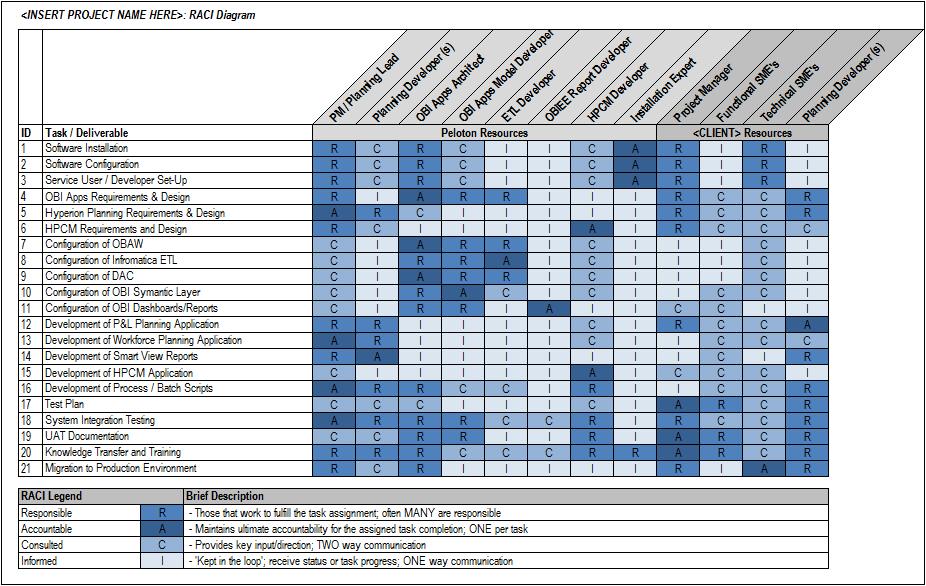You have developed your Enterprise Performance Management (EPM) Roadmap, done all the research, conducted a current state assessment, established your EPM vision, and finally selected the EPM application that you would like to implement. Great! Now what? Those two little words have plagued many EPM first-timers, making the process of getting started quite overwhelming. This article aims to get your mind thinking about some of the key considerations that are often overlooked when kicking off an EPM project.
1. Involve your Stakeholders
In order to ensure the best possible end result for your organization, it is important to consistently involve the stakeholders that you are building the system for. While a simple concept, the act of getting and keeping stakeholders involved typically proves to be difficult. As defined in our prior EPM Roadmap article, a stakeholder is anyone that will be affected by the outcome of your project. Throughout the project life-cycle, stakeholders are key contributors and influencers. Some will become subject matter experts (SMEs), others will provide insight into complex business processes, and most, if not all of them, will help shape the final product. If you have completed a successful Roadmap, you will have already defined your stakeholders. You will not only have their buy-in for the vision of the initiative, but will also have a keen understanding of who they are.
To engage stakeholders throughout the initiative, it is essential to understand the level of impact this project will have on them. As the level of actual impact to a particular group or individual varies, you will want to refine your list and ensure you focus on the key stakeholders. Key stakeholders will experience the highest level of change to their current responsibilities. Start by focusing on the level of impact by group, and work your way down to the level of impact by individual. When assessing impact, it is important to note if the stakeholder will be positively or negatively impacted by the implementation.
Your list should include individuals from multiple departments in your organization. Typically, EPM implementation affects Finance, Information Technology, Accounting, Project Planning, and Operations, depending on your planned build. Understanding the stakeholder links between these departments and their impact on the initiative is vital for proper project communication. Additionally, you will need to know when to involve the right stakeholders in each of the project phases.
2. Driving Consensus and Gaining Buy-in
How will you, as a key stakeholder or project lead, get everyone on board and rowing in the same direction as one team? Since your key stakeholders span across multiple departments and each of the departments may desire different outcomes from the project, achieving agreement and/or compromising on certain objectives may be challenging. How does your organization make decisions today? What would the decision process look like if it had to cross over departments? By understanding what the current decision-making process looks like, you can clearly identify gaps and determine where you may encounter obstacles during your project. Proactively managing the decision-making process will set you and your firm up for success.
Now that you have determined where the decision gaps are, the next objective is to get your stakeholders actively engaged in the initiative. In most cases, your key stakeholders have previously been through a similar implementation. On occasion, implementations can leave stakeholders with bad first impressions due to a myriad of issues with past experiences. Thanks to your prior EPM Roadmap exercise, you have been able to get your stakeholders on board with the initiative and provide them with the information they need to stay committed to the initiative. Having socialized the idea of the implementation, you should have a good feel for your stakeholder’s level of comfort, interest, availability, and commitment to the project if he/she were to get involved.
Now that you have everyone on board, it is time to start the initiative! Building excitement for the opportunity will ultimately lead to better processes and beneficial contributions to the future state of the firm. Provide your team with information they need to understand the overall goal of the project, the project scope, and their expected involvement/responsibilities throughout the project life-cycle. Clarity leads to comfort. The detailed communication that you have with your internal and external team members will allow you to have an informed, energetic, and smooth kick-off meeting. The project sponsor should be heavily involved in the creation and delivery of the project kick-off PowerPoint presentation. The best way to set the tone that you, your internal resources, and your hired consultants are in this project together, as oneteam, is to jointly deliver the project kick-off meeting.
3. General Communication
It is now time to identify where communication could potentially breakdown between user groups. Take a look at your stakeholder analysis and work to pinpoint potential project communication pain points. By proactively identifying the potential gaps and communication risks, you can build a proper communication management plan. In that plan, you will want to address the existing department communication gaps and set the ground rules for your team going forward. What are the project communication expectations? How will you deal with communication risks and issues? Who is responsible for making decisions? A RACI (Responsible, Accountable, Consulted, Informed) Chart is a great tool to leverage when setting expectations at the onset of your project. The chart provides the project team with a clear understanding (and picture) of accountability.
RACI Chart Template:

You will also want to ensure that you have a plan in place for managing communication across all stakeholder levels (e.g. Project Team, Project Sponsorship, and Organizational Leadership). Communication expectations will need to be set with your executive team and any additional stakeholders who may play a less active role throughout the project life-cycle. Communicating with your executive team regularly will ensure that you have their support throughout each phase of the project. This is especially helpful when working to drive consensus among your stakeholders. At times, you may need to have the leadership team support your efforts in driving consensus and keeping the project team working towards the same goals and objectives.
4. Clearly Define your Scope
Before you can start building a timeline and assigning tasks, you will need to identify the goals and objectives of the project. The project scope is the definition of the work required to complete your project objectives. In order to clearly define the scope, you will need to work with your stakeholders to outline the project’s overall goals. To create a clear path going forward, it is important to also clearly define what you will not be accomplishing during this project. Setting scope limitations (what you will do versus what you will not do) will help guide your team down the path to success. With this information, they will have a strong understanding of the project’s purpose and the work that they are setting out to accomplish. Your scope will also provide you with the tools needed to build a foundation for outlining project activities, establishing project phases, assigning resources, and appropriately estimating the cost required to finish the project.
After you have clearly defined your scope, you will want to start thinking tactically about the true project goals. Acceptance Criteria is a fancy way of saying ‘In order to call this project successful, we need to have accomplished X’, with ‘X’ being the list of agreed upon success factors. This list is usually created during requirements gathering sessions and is displayed in the requirements document. Examples of success factors may include improved performance times, reduction in cycle time, enhanced process efficiencies, etc. Establish a list – including your stakeholders in the process – that will determine whether or not your project is successful. What do you want to get out of this project? If you take a look into the future, what are you celebrating when you Go-Live?
5. Thinking Through your strategy – Risk Management
Every project has some ambiguity and that uncertainty requires an approach that deals with both positive and negative risks. Risk management is how you plan to deal with risks – how to accept, avoid, or mitigate anticipated risks, and knowing how to deal with unanticipated events. It is not just a reaction to risk, but also ensuring that you have a process in place to monitor, control, and respond to potential risks. Positive risks, if you are willing to take a chance, can yield high rewards such as a significant savings in cost or time. This is where you and your stakeholders will need to decide if the risk is worth the reward. Once your scope is clear and defined, risk identification becomes slightly easier. Take a look at your current scope and work with your key stakeholders and consultants to identify and capture all potential risks to the project. Are you concerned about the performance of the system, the quality of the product, or the management of the project? Are there organizational factors that may come into play? Are there external factors that may impact the success of the project? Is resourcing an issue? Does your organization already have a process for managing risks? If procedures have already been established within your firm, make sure to communicate the approach to your stakeholders and consultants.
6. Performing a Current State Analysis – Puts you Ahead of the Game
Data is one of the most common barriers to success in an EPM Implementation. Before you embark on your journey, you should think about taking your firm through a data discovery and reconciliation process (also known as a Current State Assessment). Performing a Current State Analysis on your data before you start down the implementation path will allow you and your firm to gain a true understanding of what data is available to you, where it is located, the quality of the data, and how difficult it is to access. Additionally, you will want to make sure that you use this discovery period as an opportunity to fully understand the reasoning and processes, both functional and technical, behind your firm’s current data practices. Please note that it is especially important to understand the movement of your data from an allocation perspective (i.e. the movement of data from your Chart of Accounts (COA) out to other systems).
When you start planning for your EPM Implementation, you should do just that, plan for your future. Oftentimes, companies will make the mistake of focusing their efforts on recreating reports that exist today. With the end user in mind, broaden your horizons and start thinking through the types of analyses that will provide your firm with a better tomorrow. Now that you know where your firm stands from a data availability perspective, you can start designing your future reports.
Considerations in a Nutshell
In summary, you can stay ahead of the game by taking these six Key Considerations into account before you kick off your EPM project:
- Involve your Stakeholders
- Gain Internal Support and Drive Consensus
- Clearly Define Scope
- Communicate
- Proactively Approach Risk Management
- Clean your Data!


